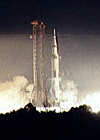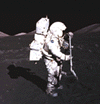|
| |

Apollo 17
 |
(C)
Eugene A. Cernan |
Commander |
| (R) Ronald E.
Evans |
Command Module Pilot |
| (L) Harrison
H. Schmitt |
Lunar Module Pilot |
Crew Spaceflight Histories
| Eugene Cernan |
| |
Mission |
Dates |
Role |
Notes |
|
Gemini IX-A |
July 18-21, 1966 |
Pilot |
|
| |
Apollo
10 |
May 18-26, 1969 |
Lunar Module Pilot |
|
| |
Apollo
17 |
December 7-19,
1972 |
Commander |
Last man to
walk on the Moon. |
| |
| Ronald B. Evans |
| |
Mission |
Dates |
Role |
Notes |
| |
Apollo
17 |
December 7-19,
1972 |
Command Module
Pilot |
|
| |
| Harrison H. Schmitt |
| |
Mission |
Dates |
Role |
Notes |
| |
Apollo
17 |
December 7-19,
1972 |
Lunar Module
Pilot |
First trained
scientist (geologist) to set foot on the moon. |
| |
Apollo 17 Backup Crew:
 The
successful Apollo 17 manned lunar landing mission was the last in a series of
three J-type missions planned for the Apollo Program. The J-type missions have
been characterized by extended hardware capability, by a scientific payload
larger than the previous G- and H-series missions and by use of a battery
powered lunar roving vehicle (LRV).
As a result of these additions, the Apollo 17 mission had a duration of 12.6
days, and a time on the lunar surface of 75 hr with a total surface
traverse distance of approximately 35 km. The
successful Apollo 17 manned lunar landing mission was the last in a series of
three J-type missions planned for the Apollo Program. The J-type missions have
been characterized by extended hardware capability, by a scientific payload
larger than the previous G- and H-series missions and by use of a battery
powered lunar roving vehicle (LRV).
As a result of these additions, the Apollo 17 mission had a duration of 12.6
days, and a time on the lunar surface of 75 hr with a total surface
traverse distance of approximately 35 km.
The Saturn V carrying Apollo 17
was launched from NASA John F. Kennedy Space Center at 05:33:00 UT on December
7, 1972 (11:33:00 p.m. CST on December 6, 1972).
 The
landing site was
on the southeastern rim of Mare Serenitatis in a dark deposit between massif
units of the southwestern Montes Taurus. The
landing site was
on the southeastern rim of Mare Serenitatis in a dark deposit between massif
units of the southwestern Montes Taurus.
Scientific objectives
included geological surveying and sampling of materials and surface features
in a preselected area of the Taurus-Littrow region, deploying and activating
surface experiments, and conducting inflight experiments and photographic tasks
during lunar orbit and transearth coast.
Lunar orbit insertion, executed
at 19:47:23 GMT on December 10, placed the spacecraft into a lunar orbit of
170.0 by 52.6 nautical miles. Following a nominal descent sequence, the
spacecraft landed at 19:54:57 GMT on December 11 in a valley at Taurus-Littrow,
less than 200 m from the preferred landing point.
The first lunar surface EVA began
at 23:54:49 GMT on December 11, with Cernan stepping out of the spacecraft at
00:01:00 GMT on December 12. Deployment of the Apollo lunar-surface experiments
package (ALSEP) and the cosmic ray experiment took place during EVA-1. Duration
of this EVA was 7 hr 12 min.
 The
second EVA began
at 23:28:06 GMT on December 12. Using the LRV,
samples from Nansen Crater, Lara Crater and others were collected. Traverses,
core samples and trenches were dug at different stations. This EVA lasted 7 hr
37 min. The
second EVA began
at 23:28:06 GMT on December 12. Using the LRV,
samples from Nansen Crater, Lara Crater and others were collected. Traverses,
core samples and trenches were dug at different stations. This EVA lasted 7 hr
37 min.
 During
EVA-3, sampling stops were made and traverse gravimeter measurements were taken.
Additional explosive packages for the Lunar Seismic Profiling Experiment were
also deployed. One of the final science activities was the retrieval of the
neutron flux probe from the deep drill core hole. The third EVA ended at
05:40:56 GMT on December 14. During
EVA-3, sampling stops were made and traverse gravimeter measurements were taken.
Additional explosive packages for the Lunar Seismic Profiling Experiment were
also deployed. One of the final science activities was the retrieval of the
neutron flux probe from the deep drill core hole. The third EVA ended at
05:40:56 GMT on December 14.
 The
LM ascent stage lifted off the Moon at 22:54:37 GMT on December 14. Lift-off and
ascent were recorded by the ground-commanded television assembly on the LRV.
After docking with the CSM, the ascent stage was sent back to the lunar surface.
Its impact was recorded by the four Apollo 17 geophones and by each ALSEP at the
Apollo 12, 14,
15 and 16
landing sites. The
LM ascent stage lifted off the Moon at 22:54:37 GMT on December 14. Lift-off and
ascent were recorded by the ground-commanded television assembly on the LRV.
After docking with the CSM, the ascent stage was sent back to the lunar surface.
Its impact was recorded by the four Apollo 17 geophones and by each ALSEP at the
Apollo 12, 14,
15 and 16
landing sites.
| Launch: |
December 7, 1972
05:33:00 UT (12:33:00 am EST) Kennedy Space Center Launch Complex39A |
| Landing Site: |
Taurus-Littrow
(20.18N, 30.76E) |
| Landed on Moon: |
December 11, 1972 19:54:57 UT (02:54:57 p.m.
EST)
|
| EVA duration: |
22 hours 4 minutes
( EVA 1: 7 hr 12 min, EVA 2: 7 hr 37 min., EVA
3 ended at 05:40:56 GMT on December 14.)
|
| Lunar Surface Traversed |
30 kilometers |
| Moon Rocks Returned: |
110 kilograms |
| LM Departed Moon: |
December 14, 1972 22:54:37 UT (5:54:37 p.m.
EST)
|
| Time on Lunar Surface: |
74 hr. 59 min. 40 sec. [19:54:57 UT December
11, 1972 - 22:54:37 GMT December 14, 1972]
|
| Returned to Earth: |
December 19, 1972
splashdown at 19:24:59 UT (2:24:59p.m. EST) |
| Mission Duration: |
301 hr. 51 min. 59
sec. |
| Retrieval site: |
Pacific Ocean 17°
53' S, 166° 7' W |
| Retrieval ship: |
U.S.S.
Ticonderoga |
|
Special Payload:
- Third mission with a lunar roving vehicle (LRV)
that could transport two astronauts. The LRV could also carry tools,
scientific equipment, communications gear, and lunar samples.
|
|
Highlights:
|
|

 The
successful Apollo 17 manned lunar landing mission was the last in a series of
three J-type missions planned for the Apollo Program. The J-type missions have
been characterized by extended hardware capability, by a scientific payload
larger than the previous G- and H-series missions and by use of a battery
powered lunar roving vehicle (LRV).
As a result of these additions, the Apollo 17 mission had a duration of 12.6
days, and a time on the lunar surface of 75 hr with a total surface
traverse distance of approximately 35 km.
The
successful Apollo 17 manned lunar landing mission was the last in a series of
three J-type missions planned for the Apollo Program. The J-type missions have
been characterized by extended hardware capability, by a scientific payload
larger than the previous G- and H-series missions and by use of a battery
powered lunar roving vehicle (LRV).
As a result of these additions, the Apollo 17 mission had a duration of 12.6
days, and a time on the lunar surface of 75 hr with a total surface
traverse distance of approximately 35 km.